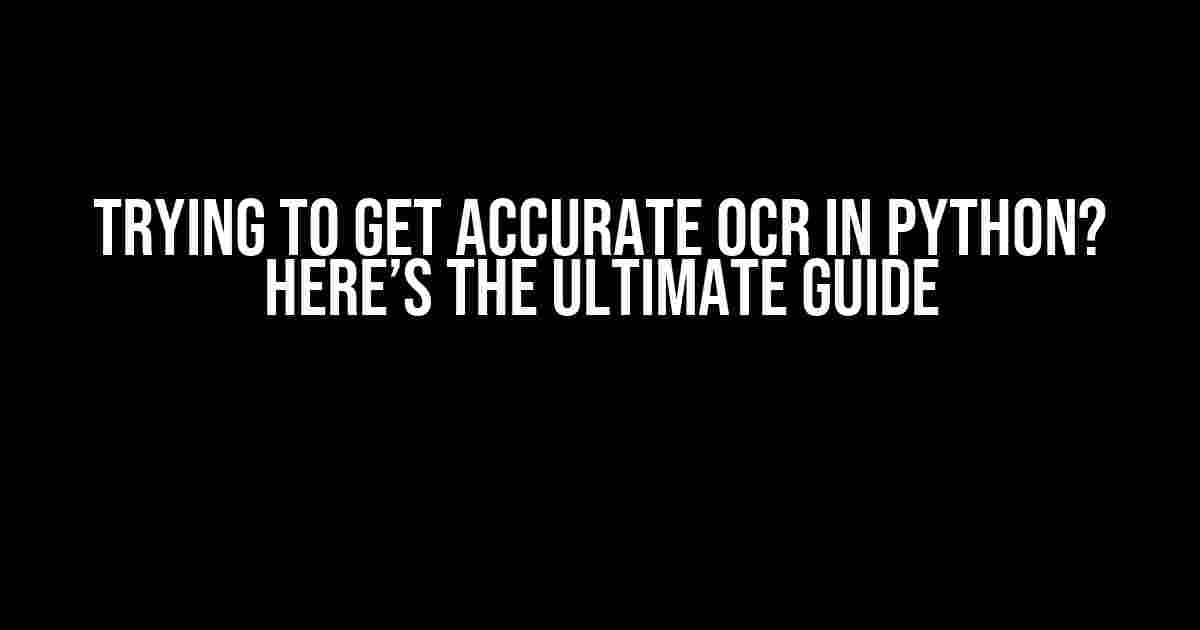Optical Character Recognition (OCR) is a powerful technology that enables computers to recognize and extract text from images. However, achieving accurate OCR in Python can be a challenging task, especially for those new to the field. In this article, we’ll delve into the world of OCR and provide you with a step-by-step guide on how to get accurate OCR in Python.
Understanding OCR and Its Applications
Before we dive into the nitty-gritty of achieving accurate OCR, let’s take a step back and understand what OCR is and its applications. OCR is a technology that enables computers to extract text from images, scanned documents, and other digital files. This technology has numerous applications, including:
- Document digitization: OCR enables organizations to digitize large volumes of paper-based documents, making them searchable and easily accessible.
- Automated data entry: OCR technology can be used to extract data from forms, invoices, and other documents, reducing manual data entry and increasing productivity.
- Image recognition: OCR is used in image recognition applications, such as self-driving cars, facial recognition, and object detection.
- Language translation: OCR technology is used in language translation applications, enabling real-time translation of text from one language to another.
Choosing the Right OCR Library for Python
When it comes to achieving accurate OCR in Python, the first step is to choose the right OCR library. There are several OCR libraries available for Python, including:
| Library | Description | Accuracy |
|---|---|---|
| Tesseract-OCR | A popular open-source OCR engine developed by Google. | Highly accurate, especially for printed text. |
| PyOCR | A Python wrapper for Tesseract-OCR. | Slightly less accurate than Tesseract-OCR, but easier to use. |
| OpenCV | A computer vision library that includes OCR capabilities. | Fairly accurate, but requires additional processing steps. |
| GOCR | An open-source OCR engine. | Less accurate than Tesseract-OCR and PyOCR. |
In this article, we’ll focus on using Tesseract-OCR, as it’s one of the most accurate and widely used OCR libraries available.
Installing Tesseract-OCR and Pytesseract
To get started with Tesseract-OCR, you’ll need to install the following:
- Install Tesseract-OCR using the following command:
pip install tesseract-ocr - Install Pytesseract using the following command:
pip install pytesseract
Once you’ve installed both Tesseract-OCR and Pytesseract, you’re ready to start extracting text from images.
Preprocessing Images for OCR
Before you can extract text from images using OCR, you need to preprocess the images to improve their quality. Here are some steps you can take:
- Binarization: Convert the image to binary format to enhance the contrast between text and background.
- Thresholding: Apply thresholding to remove noise and enhance the text.
- Deskewing: Deskew the image to correct any skew or rotation.
- Removing noise: Remove any noise or artifacts from the image.
You can use OpenCV to perform these preprocessing steps. Here’s an example code snippet:
import cv2
# Load the image
image = cv2.imread('image.png')
# Convert the image to grayscale
gray = cv2.cvtColor(image, cv2.COLOR_BGR2GRAY)
# Apply thresholding
thresh = cv2.threshold(gray, 0, 255, cv2.THRESH_BINARY_INV + cv2.THRESH_OTSU)[1]
# Deskew the image
coords = np.column_stack(np.where(thresh > 0))
angle = cv2.minAreaRect(coords)[-1]
(h, w) = image.shape[:2]
center = (w // 2, h // 2)
M = cv2.getRotationMatrix2D(center, angle, 1.0)
rotated = cv2.warpAffine(image, M, (w, h))
# Remove noise
kernel = np.ones((3, 3), np.uint8)
eroded = cv2.erode(rotated, kernel, iterations=1)
Extracting Text using OCR
Once you’ve preprocessed the image, you can extract text using OCR. Here’s an example code snippet using Pytesseract:
import pytesseract
# Load the preprocessed image
image = cv2.imread('preprocessed_image.png')
# Extract text using OCR
text = pytesseract.image_to_string(image, lang='eng', config='--psm 11')
# Print the extracted text
print(text)
In this example, we’re using the `image_to_string` function from Pytesseract to extract text from the preprocessed image. We’re specifying the language as English (`lang=’eng’`) and the page segmentation mode as 11 (`config=’–psm 11’`), which is suitable for most documents.
Tips and Tricks for Improving OCR Accuracy
To improve the accuracy of your OCR models, here are some tips and tricks:
- Image quality matters: The quality of the input image has a significant impact on OCR accuracy. Make sure to use high-quality images or preprocess them to improve their quality.
- Choose the right OCR engine: different OCR engines are better suited for different types of documents. Experiment with different engines to find the one that works best for your use case.
- Preprocess, preprocess, preprocess: Preprocessing is key to achieving accurate OCR. Make sure to apply the right preprocessing techniques to your images.
- Train your own OCR model: If you have a large dataset of labeled images, you can train your own OCR model using machine learning algorithms like convolutional neural networks (CNNs).
- Use language models: Using language models like NLTK or spaCy can help improve OCR accuracy by providing contextual information.
Conclusion
Achieving accurate OCR in Python requires a combination of the right OCR library, preprocessing techniques, and fine-tuning. By following the steps outlined in this article, you’ll be well on your way to extracting text from images with accuracy. Remember to experiment with different OCR engines, preprocess your images, and fine-tune your models to achieve the best results.
If you have any questions or need further guidance, feel free to ask in the comments below. Happy coding!
Here is an example of 5 Questions and Answers about “Trying to get accurate OCR in Python” in HTML format:
Frequently Asked Question
Get accurate OCR results in Python can be a challenge, but don’t worry, we’ve got you covered!
What are the common issues that affect the accuracy of OCR in Python?
Common issues that affect OCR accuracy in Python include low-quality images, inconsistent font styles, varying font sizes, and inadequate pre-processing of images. Make sure to optimize your images and choose the right OCR library for your project.
How do I choose the right OCR library for my Python project?
Popular OCR libraries for Python include Tesseract, PyOCR, and OpenCV. Consider factors such as language support, accuracy, and ease of use when selecting an OCR library. Tesseract is a popular choice due to its high accuracy and support for over 100 languages.
What pre-processing techniques can I use to improve OCR accuracy?
Techniques such as binarization, thresholding, and deskewing can improve OCR accuracy by enhancing image quality. You can also use filters to remove noise and correct for orientation. OpenCV provides an implementation of these techniques that can be easily integrated into your Python project.
How can I handle multi-language documents with OCR in Python?
Use an OCR library that supports multiple languages, such as Tesseract. You can also use language detection libraries like LangID or Polyglot to identify the language of the text before passing it to the OCR engine.
What are some best practices for evaluating OCR accuracy in Python?
Use metrics like precision, recall, and F1-score to evaluate OCR accuracy. Test your OCR model on a validation set and tune hyperparameters to optimize performance. You can also use tools like OCR benchmarking datasets to compare your model’s performance with baseline models.


